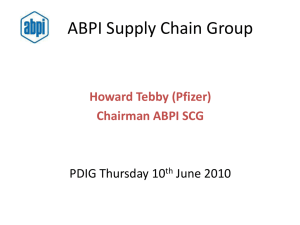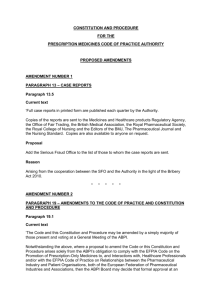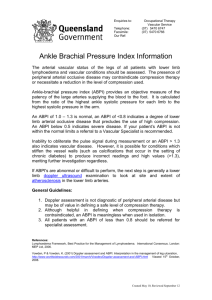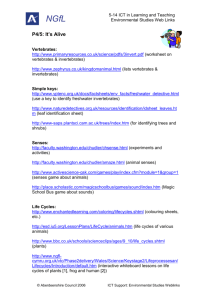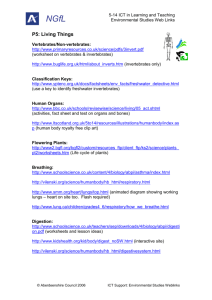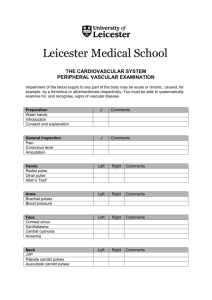PPRS Formal Review Meeting Minutes
advertisement
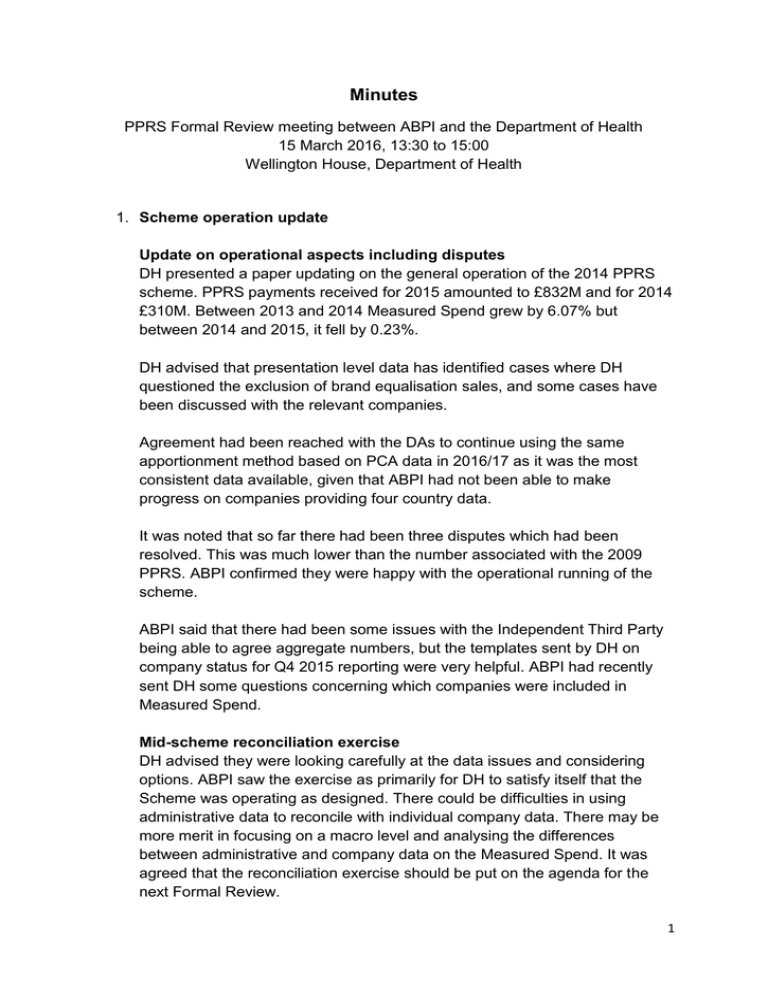
Minutes PPRS Formal Review meeting between ABPI and the Department of Health 15 March 2016, 13:30 to 15:00 Wellington House, Department of Health 1. Scheme operation update Update on operational aspects including disputes DH presented a paper updating on the general operation of the 2014 PPRS scheme. PPRS payments received for 2015 amounted to £832M and for 2014 £310M. Between 2013 and 2014 Measured Spend grew by 6.07% but between 2014 and 2015, it fell by 0.23%. DH advised that presentation level data has identified cases where DH questioned the exclusion of brand equalisation sales, and some cases have been discussed with the relevant companies. Agreement had been reached with the DAs to continue using the same apportionment method based on PCA data in 2016/17 as it was the most consistent data available, given that ABPI had not been able to make progress on companies providing four country data. It was noted that so far there had been three disputes which had been resolved. This was much lower than the number associated with the 2009 PPRS. ABPI confirmed they were happy with the operational running of the scheme. ABPI said that there had been some issues with the Independent Third Party being able to agree aggregate numbers, but the templates sent by DH on company status for Q4 2015 reporting were very helpful. ABPI had recently sent DH some questions concerning which companies were included in Measured Spend. Mid-scheme reconciliation exercise DH advised they were looking carefully at the data issues and considering options. ABPI saw the exercise as primarily for DH to satisfy itself that the Scheme was operating as designed. There could be difficulties in using administrative data to reconcile with individual company data. There may be more merit in focusing on a macro level and analysing the differences between administrative and company data on the Measured Spend. It was agreed that the reconciliation exercise should be put on the agenda for the next Formal Review. 1 2. PPRS payments review ABPI presented their comparison of IMS reported sales with Measured Spend for Q4 2014 and Q4 2015. IMS data reported 7.8% growth from 2014 to 2015 in sales at list price for branded medicines sold by companies in the scheme, whereas the PPRS Measured Spend growth reported by the same companies declined by 0.2% from 2014 to 2015. The ABPI analysis showed that certain exclusions, including parallel imports, were increasing and this accounted for part of the ‘gap’ between IMS and PPRS Measured Spend. However there was a significant residual gap which in 2015 grew by 65%. ABPI highlighted their view that this residual gap was mainly accounted for by discounting to the NHS. The change in product mix over time may lead to discounting being a larger share of IMS measured sales, because newer products were increasingly subject to formal discounts schemes (PAS, CDF) and therefore had higher list prices compared to their actual selling prices. DH pointed out that the residual gap had grown by £570m between 2014 and 2015 but that PPRS companies share of sales at list price had increased by £827m. So even if this residual gap was all accounted for discounts, it had not resulted in a saving in the drugs bill for the NHS and did not account for the difference between administrative data and company reported data on spend. DH reported that a reconciliation with Trust reports had confirmed that Pharmex does capture PAS discounts accurately, but ABPI said they thought Pharmex may not include all rebates (including those relating to the CDF), and would like to analyse the difference between data sources to determine volumes and spend growth. The ABPI proposed that DH use the 2014 unaudited presentation level sales report to review the impact of discounts in the ABPI analysis, then repeat this when the 2015 reports are submitted by Member companies. DH presented their paper, highlighting the slowdown in growth reported by companies in the first second year and the fact that growth was now significantly below the original projected profile for this stage of the Scheme. The analysis showed that the increase in parallel imports accounted for circa £100m reduction in PPRS payments in 2015/16, with switching and divestments to the statutory scheme accounting for c.£50m. DH would continue to monitor PIs and would expect these sales to start to fall off following the recent weakening of the pound. 2 The trend in growth reported by companies in the PPRS and resulting payment profile creates risk for the DH and NHS budget in respect of PPRS payments. Both sides agreed that it was important to work together to understand what the dynamics of medicines spend and that a joint workshop would be necessary. It was agreed that the discussion at MAG on medicines update had been a useful exercise and that MAG was the right forum for joint discussion between DH, ABPI and NHS England on the broader issue of access to medicines. 3. PPRS commitments review Access and outcomes ABPI acknowledged good progress on commitments for which DH/NICE are directly responsible, but ABPI was concerned that progress on those requiring NHS involvement was less clear. ABPI confirmed that the concept of MISG is valued but queried the level of engagement at senior levels. DH advised pursuing this issue with OLS. ABPI welcomed the regional medicines optimisation committees being set up by NHSE and acknowledged the progress with the innovation scorecard. DH noted that the figures on increased access for scorecard products were very significant. ABPI noted that there remains variation in uptake versus NICE estimates and advised that there was a need to understand regional variation in uptake as well as understanding the trends of medicines use in the UK versus international comparisons. ABPI noted that data showed the UK adopted newer NICE approved medicines at a slower rate than other countries. ABPI offered to provide data on variation and DH said they would take up cases of unwarranted variation with NHSE. Second half of scheme focus ABPI requested a review of the PAS system and flexible pricing (though it was noted that, under the PPRS, the request would have needed to have been agreed before the end of 2015). The ABPI argued that very few complex PASs were agreed, which did not fit the direction of travel and the need for more flexible commercial access arrangements envisaged under the AAR. DH advised that as the AAR was considering such issues they would want to await the final report before making any commitments. However, DH argued that it was not correct that few complex PASs were agreed: in the last 18 months, PASLU’s advice was positive for 70% of complex PAS proposals. DH agreed to return to this issue following publication of the AAR. 3 ABPI raised the issue of funding flows and the opinion of companies that PPRS payments were not going back into medicines spend. Companies were concerned that NHSE was not taking the PPRS payments into consideration, and therefore there was less incentive for early uptake. DH pointed out that not all spend on branded medicines was covered by PPRS payments and NHSE had to take into account the CDF agreement which reduced the amount repaid by companies through the PPRS. DH understood the importance companies place on the visibility of payments, but pointed out that this issue had been discussed extensively and that ringfencing PPRS payments was not possible under normal NHS financial rules. DH kept in close touch with NHSE Finance. The disadvantage of ring-fencing payments would be greater visibility in the reduction in income from the expected levels – at present, CCGs and NHSE were protected from this to a significant extent. ABPI pointed out that lack of clarity on funding flows might be an impediment to future agreements. AOB DH said they expected the next report to Parliament to be published early in 2017. ABPI welcomed this, but advised they could not support publication of international actual selling price comparisons as there is no available source of data on net prices. DH advised that if the report showed only list price data it would have to be heavily caveated, particularly given the data ABPI had shared on the growing gap between list price and actual selling price data in the UK. DH asked ABPI to send them a clear statement that it was not possible to provide international comparisons on a net price basis given that this question came up frequently within Government. DH provided an update on the DH2020 programme. The aim was to reduce the Department costs by 30%. The Lord Carter report had recommended that consideration be given to locating CMU with the NHS, but no decisions had yet been made on structure. DH confirmed that responses to the statutory scheme consultation were still under consideration. Date of next meeting: It was agreed that the next meeting should be arranged for September and would be chaired by DH. 4
